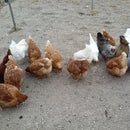Introduction: Instant Animal Cage for Transport
I needed to transport my two French Alpine goats to a farm 40 miles away so that they could breed with an Alpine buck. I have a pickup truck that has a full 8 ft bed with a liner and was trying to figure out how to rig it so that the goats could be transported safely. I thought of building a cage around the bed using stakes in the stake pockets along the sides of the bed. However, I already have tie down anchors installed and really didn't want to remove them because I use them all the time.
I searched the web for how people made cages out of different materials and found the classic cage made of sections of a wire cattle panel. Basically, you cut sections of the panel for each side and the top and then join them together with zip ties. That sounded easy enough but would take a little work cutting the panel. I would also need two panels to do the job.
Step 1: "Building" the Cage
I went to my local Tractor Supply to see what was available and found a variety panels. All were 16 ft long but differed in the spacing of wires and their height. They actually had a goat panel but the cattle panel was actually a little cheaper at $19.95. I decided to buy it. It is 16 ft by 50 inches high. My next task was to figure out how to transport it to my farm. The young gentleman who helped me load it had the perfect solution. We stood the panel up vertically and formed a U-shape without making a permanent bend at the base of the U. In that configuration, the panel fit perfectly into the bed. Once I saw that, it struck me that I could put the goats into space formed by the U and the pull the two ends together.
In the first photo you can see the panel sitting in the truck without the ends tied together. In the second the goats are now in there and the ends have been pulled together and tied. I have collars on the goats and have short leashes for each one. I attached the leash to a lower rung of the panel by passing the working end of the leash through the loop. I then snapped the leash to the collar of the goat. After the ends were tied together, I then tied the cage in several places to the tie down anchors. This way, the goats were tied to the cage and then the cage was tied to the truck.
I had assumed that the goats would lied down during the trip but they stood the whole way watching the sights go by. They appear to be jammed into the cage but they really weren't because were moving around some. It was better that there wasn't too much room because there was less chance of them being thrown around by the movement of the truck. If it were any colder (it was in the high 50's F), I would have taken a tarp and wrapped it around the outside of the cage. However, I would only do the lower part of cage because I think the goats would be more comfortable being able to look out.
I now can store the panel at my farm and use it for moving animals anytime I have to. I am thinking of getting some young calves in the future and the cage should work for that as well. If they are too big, I could move them one at a time. I think I impressed myself how something so complicated in my mind got resolved with a very simple solution. BTW, if you only have a six foot bed, I think this would still work but you might have to leave the back gate down.













